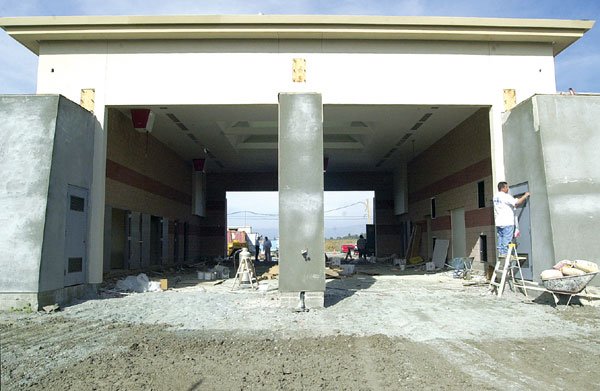GILROY
– Just two paramedics on duty at a time at the city’s new, third
fire station on Sunrise Drive have been enough to lessen the
emergency medical response time in northwestern Gilroy by two
minutes.
Gilroy Fire Department officials see this as a clear validation
for building the station and a good reason to get it up to full
staff as soon as possible.
A tight city budget outlook for the coming year could postpone
the date when the Sunrise station will have a full paramedic staff
and any firefighters at all. Depending on circumstances, it could
mean cutting the six GFD staff working there now.
GILROY – Just two paramedics on duty at a time at the city’s new, third fire station on Sunrise Drive have been enough to lessen the emergency medical response time in northwestern Gilroy by two minutes.
Gilroy Fire Department officials see this as a clear validation for building the station and a good reason to get it up to full staff as soon as possible.
A tight city budget outlook for the coming year could postpone the date when the Sunrise station will have a full paramedic staff and any firefighters at all. Depending on circumstances, it could mean cutting the six GFD staff working there now.
Fire Chief Jeff Clet said the City Council can be satisfied that paramedic service has been so improved with just a small staff at Sunrise.
“When we can afford it, I think the next step is to make it a full-service fire station … consistent with the other two stations (Chestnut and Las Animas),” Clet said.
On Aug. 1, 2003, three GFD captains and three paramedics began working two-person shifts at the Sunrise station. Before that, in the second quarter of 2003 (April 1 to June 30), paramedics from the Las Animas station responded to 95 percent of emergency medical calls in the Sunrise Fire District in northwest Gilroy in eight minutes and 27 seconds or less, according to GFD records. In the third quarter (July 1 to Sept. 30), it dropped to 6 minutes, 31 seconds.
Broaden the frequency to 90 percent of the time, and the Sunrise paramedics arrived in less than 6 minutes, according to GFD Analyst Geoff Cady.
These response times are only for the types of calls the Sunrise teams handle on its own. It doesn’t include fire calls or calls in the city’s three other fire districts – or calls that require more than two paramedics, as when someone is not breathing or in cardiac arrest.
“About 95 percent of EMS calls can be handled by these two (people),” Cady said Friday.
Even in heart attack cases or when someone can’t breathe, these two paramedics can do a lot to help save someone’s life. They can run a heart defibrillator and do CPR, Cady said, but they need to call paramedics from the Las Animas station on Wren Avenue – who usually take an extra two minutes or so to arrive – to do the other procedures often necessary in these cases.
“They have the tools, but they don’t have all of the hands,” Cady said.
Even a six-minute response time is often not enough to save a heart attack victim.
“Brain death seems to occur sometime between four and six minutes,” Cady said. “With the deployment of that (Sunrise) unit, we are as close as most systems can get.”
Santa Clara County requires paramedic services that contract with the county to respond to emergency medical calls within 7 minutes, 59 seconds 90 percent of the time. The GFD entered this contract on July 1.
The city of Santa Clara’s fire department and paramedics have one of the county’s best response times, Cady said, and he thinks Gilroy could learn something from that city.
“They have built fire stations within a relatively close proximity of each other,” Cady said. “Those are the kind of planning decisions that have to be made.”
And they are being made as city officials work through a master planning process. At a recent retreat, City Council members and GFD officials tentatively discussed planning future fire stations so there is no more than four minutes of travel time from one to the next.
Although the city has only two full-service fire stations, it has four fire districts: One each for the Chestnut, Las Animas and Sunrise fire stations as well as one for the city’s southwest portion, called the Santa Teresa District. This fourth district is sparsely populated right now, but that is expected to change with the expansion of one housing development, Eagle Ridge, and the influx of two more: the recently approved Mesa Ridge and Glen Loma, which Clet called “probably the largest single development in the city’s history.”
City officials know they will eventually need a fourth fire station in the Santa Teresa District, Clet said. When, however, depends on the speed of population growth in southwest Gilroy.
In the meantime, Cady and the GFD are collecting data on fire and emergency calls to the Santa Teresa District to help them plan for the future.
Further down the road, Cady said Gilroy would need a fifth fire station if it annexes 660 acres to the northeast, as has been discussed.
Sunrise currently receives between 30 and 40 calls each month, about half as many as the two older stations.
The actual fire house at 880 Sunrise Drive is not yet complete; staff currently work out of a temporary 60-by-14-foot trailer located nearby. The permanent station is expected to open later this spring.
The Sunrise station was expected to cost $3.7 million to build. The trailer cost $12,000. A new Supplemental Transport Ambulance Resources vehicle, or STAR unit, cost $268,000. As of last summer, the GFD expected the salaries and benefits for Sunrise’s two-person crews to cost $862,622 this fiscal year, which ends June 30. That’s more than $4.8 million already spent.
To fully staff Sunrise, Clet has said a total of nine new firefighters will have to be hired. Extrapolating from the pay for the current six, Sunrise’s 15-person crew would cost more than $2.1 million a year, not counting future raises or new fire and rescue vehicles.
Capt. Gil Horta and Paramedic Loni Antonio, Capt. Moe McHenry and Paramedic Heinz Maibaum, and Capt. Clay Bentson and Paramedic Chris Weber presnetly work At present, those who work at the Sunrise station.














